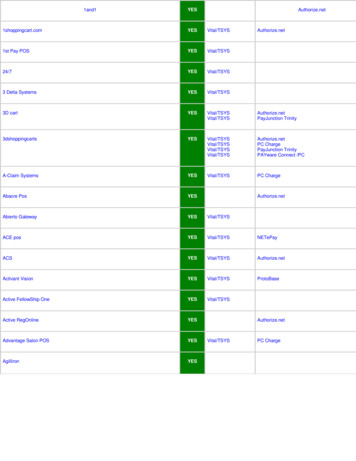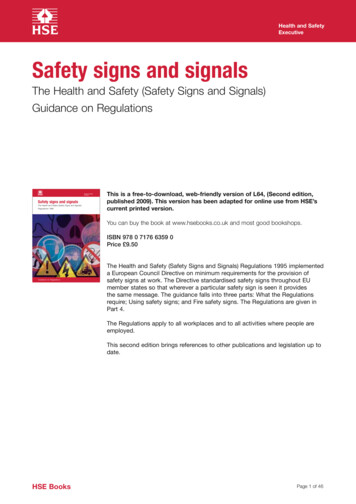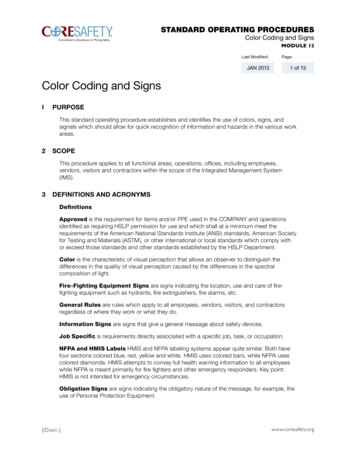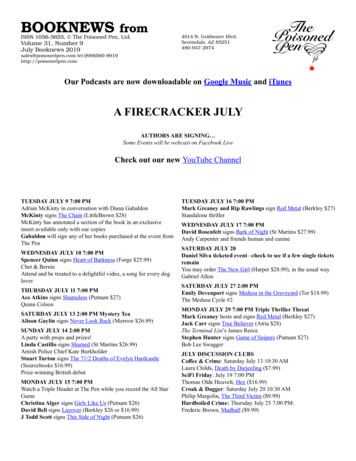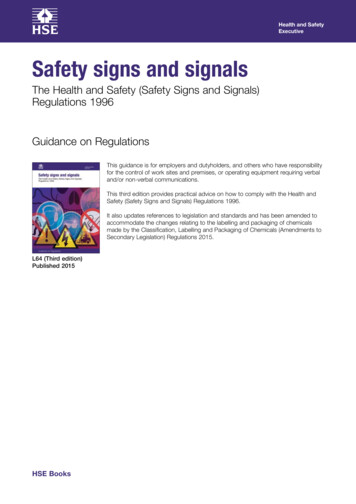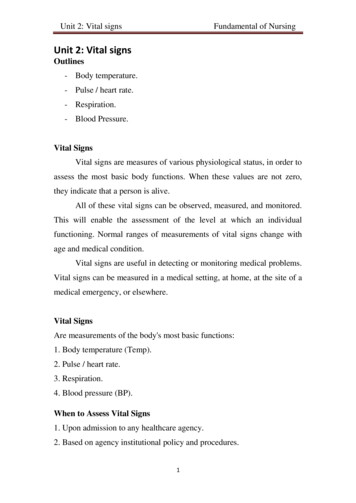
Transcription
Unit 2: Vital signsFundamental of NursingUnit 2: Vital signsOutlines- Body temperature.- Pulse / heart rate.- Respiration.- Blood Pressure.Vital SignsVital signs are measures of various physiological status, in order toassess the most basic body functions. When these values are not zero,they indicate that a person is alive.All of these vital signs can be observed, measured, and monitored.This will enable the assessment of the level at which an individualfunctioning. Normal ranges of measurements of vital signs change withage and medical condition.Vital signs are useful in detecting or monitoring medical problems.Vital signs can be measured in a medical setting, at home, at the site of amedical emergency, or elsewhere.Vital SignsAre measurements of the body's most basic functions:1. Body temperature (Temp).2. Pulse / heart rate.3. Respiration.4. Blood pressure (BP).When to Assess Vital Signs1. Upon admission to any healthcare agency.2. Based on agency institutional policy and procedures.1
Unit 2: Vital signsFundamental of Nursing3. Any time there is a change in the patient’s condition.4. Before and after surgical or invasive diagnostic procedures.5. Before and after activity that may increase risk.6. Before and after administering medications that affect cardiovascularor respiratory functioning.Physiological Basis of Body TemperatureBody temperature is the balance between the heat production dueto chemical activities by the body and heat lost from the body throughradiation, conduction, convection, and vaporization( evaporation) .Types of body temperature:1. Core temperature:Is the temperature of deep tissues of the body, e.g., cranium, thoraxand abdominal cavity. It remains relatively constant (37Cº or 98.6 Fº).True core temperature readings can only be measured by invasivemeans, such as placing a temperature probe into the esophagus,pulmonary artery or urinary bladder.Non-invasive sites such as the rectum, oral cavity, axilla, temporalartery (forehead) and external auditory canal are accessible and arebelieved to provide the best estimation of the core temperature.2.Surface temperature:Is the temperature of the skin, the subcutaneous tissue and fat. It,by contrast rises and falls in response to the environmental changes.When measured orally, the average body temperature of an adult isbetween 36.7 Cº( 98 Fº) and 37 Cº( 98.6Fº).Assessing Body TemperatureThe normal range of the body temperature is between 36.2 to 37.2 Cº.2
Unit 2: Vital signsFundamental of NursingFactors Affecting Body's heat production1.Basal metabolic rate ( BMR): The basal metabolic rate is the rate ofenergy utilization in the body to maintain essential activities such asbreathing. BMRs vary with age and sex.2.Muscle activity: It including shivering, can greatly increase metabolicrate.3.Thyroxin output: Increased thyroxin output increases the rate ofcellular metabolism throughout the body.4.Epinephrine and sympathetic stimulation, these immediately increasethe rate of cellular metabolism in many body tissues.5.Age: Very young and very old are more sensitive to change inenvironmental temperature due to decreased thermoregulatory controls6.Gender: women tend to have more function in body temperature thanmen the increase in progesterone secretion at ovulation increase bodytemperature .7.Diurnal variation: body temperature normally change throughout theday, varying as much as I Cº ( I.8 ºF) between the early morning and thelate afternoon.8.Exercise: Hard work or strenuous exercise can increase bodytemperature to as high as 38.3Cº to 40 Cº( 101 to 104 ºF) measuredorally.Alterations in Body TemperaturePyrexia: A body temperature above the usual range is called pyrexia,hyperthermia, or ( in lay terms) fever. A very high temperature, e.g. 41Cº(105 ºF) is called hyperpyrexia.3
Unit 2: Vital signsFundamental of NursingCommon types of fevers1.Intermittent Fever: during this type of fever, the body temperaturealternates at regular intervals between periods of fever and periods ofnormal temperatures.2.Remittent Fever: during this type of fever, a wide range of temperaturefluctuations occurs over the 2 hour period, all of which are above normal.3.Relapsing Fever: In a relapsing fever, short febrile periods of a fewdays are interspersed with periods of 1 or 2 days of normal temperature.4.Constant Fever: during a constant fever, the body temperaturefluctuates minimally but always remains elevated.Clinical Signs of FeverA: Onset ( cold or chill stage)1. increased heart rate and respiratory rate and depth.2. Shivering due to increased skeletal muscle tension and contraction.3. Cold skin due to vasoconstriction.4. Cyanotic nail beds due to vasoconstriction.5. Complain of feeling cold.6. Gooseflesh appearance of the skin.7. Rise in body temperature.B: Course1.Skin feels warm.2. increased pulse and respiratory rate.3. increased thirst.4. mild to severe dehydration.5. drowsiness, restlessness, or delirium and convulsions due to irritationof the nerve cells/6. loss of appetite with prolonged fever.4
Unit 2: Vital signsFundamental of Nursing7. malaise, weakness, and aching muscles due to protein breakdown.C: Abatement stage1. Flushed and warm skin .2. Sweating.3. Decreased shivering.4. Possible dehydration.Treatment of Increasing Body Temperature1. Antipyretics.2. Cold sponge bath .3. Cold compresses .Nursing Interventions for patient with Fever1. Monitor vital signs.2.Assess skin color and temperature.3.Monitor WBCs count and other pertinent laboratory records.4. Remove excess clothes when the patient feels warm, but provide extrawarmth when the patient feels chilled.5. Measure intake and output.6.Reduced physical activity to limit heat production.7. Provide oral hygiene to keep the mucous membranes moist. They canbecome dry and cracked as a result of excessive fluid loss.8. Applied moist cold applications such as cold compresses tepid spongeand ice bag to increase loss through conduction.9. Provide cool circulating air by using a fan to increase heat loss throughconvection.Hypothermia5
Unit 2: Vital signsFundamental of NursingIt is a core body temperature below the lower limit of normal. Theability of hypothalamus to regulate temperature is greatly impaired whenthe body temperature falls below 34.5Cº ( 94 ºF), and death usuallyoccurs when the temperature falls below 34 Cº (93.2 ºF).Physiological Process of hypothermia1. Excessive cold environment.2. Inadequate heat production to counteract the heat loss.3. Impaired hypothalamus thermoregulation.Clinical signs of hypothermia1. Decreased body temperature.2. Pale, cool, waxy skin.3. Hypotension.4. Decrease urine output.5. Lack of muscle coordination.6. Disorientation.7. Drowsiness may progressing to coma.Sites for Assessing Body Temperature1.Orally (common way). 37 C (3–5 min).The oral cavity temperature is considered to be reliable when thethermometer is placed posteriorly into the sublingual pocket. Thislandmark is close to the sublingual artery, so this site tracks changes incore body temperature.2.Axillary (safe way). 36 C 0.5 C (10 min).Temperature is measured at the axilla by placing the thermometerin the central position and adducting the arm close to the chest wall. isconsidered to be an unreliable site for estimating core body temperature6
Unit 2: Vital signsFundamental of Nursingbecause there are no main blood vessels around this area, therefore shouldadd 0.5C to the actual reading.3. Rectal (accurate reading).37 C – 0.5 C (2 – 3 min).Rectal temperature is the most accurate method for measuring thecore temperature, and should reduce 0.5 C to the actual reading.4. Tympanic membrane.The tympanic thermometer senses reflected infrared emissionsfrom the tympanic membrane through a probe placed in the externalauditory canal. This method is quick ( 1 minute), minimally invasive andeasy to perform. It has been reported to estimate rapid fluctuations in coretemperature accurately because the tympanic membrane is close to thehypothalamus.Contraindications of oral thermometer1. The child under 6 years .2. Unconscious patients .3. Psychiatric patients .4. Patient who cannot breath from his nose5. Mouth surgery or infection .6. Patient on oxygen mask.Contraindications of rectal thermometer1. rectal surgery .2. rectal disorders ( hemorrhoids. Rectal fissure.etc.).3. diarrhea.Types of Thermometers1. Electronic thermometer.2. Glass thermometer.7
Unit 2: Vital signsFundamental of Nursing3. Paper thermometer.4. Tympanic membrane thermometer.Alterations in csHeat exhaustionAn increase in body temperature(38 C– 40 C, 100.4 F–104.0 F) inresponse to environmentalconditions that, in turn, causesdiaphoresis (profuse perspiration)An increase in body temperature(38 C–40 C, 100.4 F–104.0 F) inresponse to environmentalconditions that, in turn, causesdiaphoresis (profuse perspiration).A critical increase in bodytemperature (41 C–44 C, 100.6 F–112.0 F) resultingfrom exposure to highenvironmental temperature.Loss of excessive amountsof water and sodium fromperspiring leads to thirst,nausea, vomiting,weakness, anddisorientation.Heat strokeDry, hot skin is the mostimportant sign.confused or delirious andexperiences thirst,abdominal distress, musclecramps, and visualdisturbances.occurs if untreated.HypothermiaA body temperature of 35 C (95 F)or lower resulting from coldweather exposure or artificialinductionDecrease in metabolismleads to impairedmentalfunctioning and depressedpulse, respiration, andblood pressure; can resultin cardiac arrest ifuntreated.leads to impairedmentalfunctioning and depressedpulse, respiration, andblood pressure; can resultin cardiac arrest ifuntreated.FrostbiteFreezing of the body’s surface areas(earlobes, fingers, and toes) inextremely low temperatures.Conversion Formulas8Circulatory impairmentmay be followed bygangrene.
Unit 2: Vital signsFundamental of NursingSometimes a health professional staff need to convert a Celsiusreading to Fahrenheit, or vice versa.a. To convert from Fahrenheit to Celsius, deduct 32 from the Fahrenheit,and then multiply by 5/9C (Fahrenheit temperature -32) 5/9For example, convert 98.6 Fahrenheit to Celsius readingC ( 98.6- 32) 5/9C ( 66.6) 5/9C 37 Celsius degree.b. To convert from Celsius to Fahrenheit, multiply the Celsius reading bythe fraction 9/5 and then add 32 .For example, convert 37 Celsius degree toFahrenheitreadingF ( 37 9/5) 32F ( 66.6) 32F 98.6 ºFNursing DiagnosisPotential altered body temperature related to:a. illness or trauma affecting temperature regulation.b. medication or vigorous activity.Altered body temperature (hyperthermia) related to exposure toexcessively hot environment, increase metabolic rate, or dehydration.Altered body temperature (hypothermia) related exposure toexcessively cool environment, debilitating or trauma, or lack of adequateclothing and shelter.Ineffective thermoregulation related to decreased basal metabolismsecondary to aging, or trauma, or illness.Risk for imbalanced body temperature, at risk for failure to maintainbody temperature within normal range.9
Unit 2: Vital signsFundamental of NursingPulsePulse is a wave of blood created by contraction of the left ventricleof the heart. The heart is a pulsate pump and the blood enters the arterieswith each heartbeat, causing pulse waves.Pulse assessment is the measurement of a pressure pulsationcreated when the heart contracts and ejects blood into the aorta.Characteristics of Pulse1. Quality.2. Rate.3. Rhythm.4. Volume (strength or amplitude).1. Pulse quality refers to the ‘‘feel’’ of the pulse, its rhythm andforcefulness.11
Unit 2: Vital signsFundamental of Nursing2. Pulse rate is an indirect measurement of cardiac output obtained bycounting the number of apical or peripheral pulse waves over a pulsepoint.- A normal pulse rate for adults is between 60 and 100 beats per minute.- Bradycardia is a heart rate less than 60 beats per minute in an adult.- Tachycardia is a heart rate in excess of 100 beats per minute in anadult.3. Pulse rhythm is the regularity of the heartbeat. It describes howevenly the heart is beating:- Regular (the beats are evenly spaced).- Irregular (the beats are not evenly spaced).- Dysrhythmia (arrhythmia) is an irregular rhythm caused by an early,late, or missed heartbeat.4. Pulse volume is a measurement of the strength or amplitude of forceexerted by the ejected blood against the arterial wall with eachcontraction.- It is described as normal (full, easily palpable).- Weak (thready and usually rapid), or- Strong (bounding).11
Unit 2: Vital signsFundamental of NursingFactors Contribute to Increase Pulse Rate1. Pain.2. Fever.3. Stress, exercise .4. Bleeding.5. Decrease in blood pressure .6. Some medications as (adrenalin, aminophylline).Factors May Slow The Pulse1. Rest .2. Increasing age.3. People with thin body size .4. Some Medications.5. Thyroid gland disturbances .12
Unit 2: Vital signsFundamental of NursingPulse Point assessmentAnatomical locationAssessment CriteriaPulsepointTemporal Over temporal bone, superior Accessible; used routinely forand lateral to eyeinfants and when radial isinaccessible.Bilateral, under lower jaw in Accessible; used routinely forCarotidneck along medial edge of infants and during shock orsternocleidomastoid muscle.cardiac arrest when otherperipheral pulses are tooweak to palpate; also used toassess cranial circulation.Left midclavicular line at Used to auscultate heartApicalfourth to fifth intercostal sounds and assess apicalspace.radial deficit.Brachial Inner aspect between groove Used in cardiac arrest forof biceps and triceps muscle infants, to assess lower armat antecubital fossa.circulation, and to auscultateblood pressure.Inner aspect of forearm on Accessible; used routinely inRadialthumb side of wrist.adults to assess character ofperipheral pulse.Outer aspect of forearm on Used to assess circulation toUlnarfinger side of wrist.ulnar side of hand and toperform the Allens test.Femoral In groin, below inguinal Used to assess circulation toligament (midpoint between legs and during cardiac arrest.symphysispubisandanterosuperior iliac spine).Popliteal Behind knee, at center in Used to assess circulation topopliteal fossa.legs and to auscultate legblood pressure.Posterior Inner aspect of ankle between Used to assess circulation toAchilles tendon and tibia feet.tibial(below medial malleolus).instep,midpoint Used to assess circulation toDorsalis Overbetween extension tendons of feet.great and second toe.13
Unit 2: Vital signsFundamental of Nursing14
Unit 2: Vital signsFundamental of NursingPeripheral Pulse AssessmentA peripheral pulse, usually the radial pulse, is assessed by palpation forall individual except:a. newborns and children up to 2 or 3 years. Apical pulse is assessed inthese clients.b. very obese or elderly clients, whose radial pulse may be difficult topalpate. Doppler equipment may be used for these clients, or the apicalpulse is assessed.c. Individual with heart disease, who require apical pulse assessment.15
Unit 2: Vital signsFundamental of Nursingd. Individuals in whom the circulation to a specific body part must beassessed, e.g. following leg surgery the pedal ( dorsalis pedis) is assessed.Apical Pulse AssessmentAssessment of the apical pulse is indicator for clients whoseperipheral pulse is irregular as well as for clients with knowncardiovascular, pulmonary, and renal diseases. It is commonly assessedprior to administering medications that effect heart rate. The apical side isalso used to assess the pulse for newborns, infants, and children up to 2-3years old.Apical –Radial PulseAn apical-radial pulse may need to be assessed for clients withcertain cardiovascular disorders. Normally the apical and radial rates areidentical.An apical pulse rate greater than a redial pulse rate can indicatethat the thrust of the blood from the heart is too feeble for the wave to befelt at the peripheral pulse site, (or) it can indicate the vascular disease ispreventing impulses from being transmitted. Any discrepancy betweenthe two pulse rates need to be reported promptly. In no instance is theradial pulse greater than the apical pulse.Pulse deficitPulse deficit is the difference in the apical pulse and the radialpulse. These should be taken at the same time, which will require that 2people take the pulse. One with a stethoscope and one at the wrist. Countfor 1 full minute. Then subtract the radial from the apical. This is thePulse Deficit.16
Unit 2: Vital signsFundamental of NursingRespiration- Pulmonary ventilation (breathing ): movement of air in and out ofthe lungs.- Inspiration (inhalation) is the act of breathing in.- Expiration (exhalation ) is the act of breathing out .Factors Affecting Respiration1. Pain, anxiety, exercise .2. Medications .3. Trauma .4. Infection.5. Respiratory and cardiovascular disease .6. Alteration in fluids, electrolytes, acid- base balances.Assessing Respirations- Inspection.- Listening with stethoscope.- Monitoring arterial blood gas results.- Using a pulse oximeter.Control of BreathingRespiration is controlled by:1. Respiratory center in the medulla oblongata and the pons of the brain.2. Chemoreceptors located centrally in the medulla in peripherally in thecarotid and aortic bodies. These centers and receptors respond to changesin the concentration of oxygen ( O2), carbon dioxide ( Co 2), andhydrogen ( H ) levels in the arterial blood.17
Unit 2: Vital signsFundamental of NursingCharacteristics of Normal and Abnormal Breathing SoundsEupnea: refers to easy respirations with a normal rate of breaths perminute that is age specific.Bradypnea: is a respiratory rate of 10 or fewer breaths per minute.Hypoventilation: is characterized by shallow respirations.Tachypnea: is a respiratory rate greater than 24 breaths per minute.Hyperventilation: is characterized by deep, rapid respirations.The nurse can also observe alterations in the movement of the chestwall:Costal (thoracic) breathing: occurs when external intercostal musclesand the other accessory muscles are used to move the chest upward andoutward.Diaphragmatic(abdominal) breathing: occurs when the diaphragmcontracts and relaxes as observed by movement of the abdomen.Dyspnea: refers to difficulty in breathing as observed by labored orforced respirations through the use of accessory muscles in the chest andneck to breathe.Apnea : respirations cease for several seconds. Persistent cessation iscalled respiratory hmisirregular,characterized by alternating periods of apnea and hyperventilation. Therespiratory cycle begins with slow, shallow breaths that graduallyincrease to abnormal depth and rapidity. Gradually breathing slows andbecomes shallower, climaxing in a 10 to 20 seconds period of apneabefore respiration resumes.18
Unit 2: Vital signsFundamental of NursingKussmaul respiration: respirations are abnormally deep but regular,similar to hyperventilation. Characteristic of clients with diabeticketoacidosis.Orthopnea: respiratory condition in which a person must sit or stand inorder to breathe deeply or comfortably.Assessment of respiration includes;1-Depth [by assessing the degree of excursion or movement in the chestwall; shallow, deep or normal.2-Rhythm.3- Rate the nurse observes a full inspiration & expiration when counting.Normal range: 12 – 20 breath / minuteSites of breathing measurement- Normal breathing is slightly observable, effortless, quiet,automatic, and regular. It can be assessed by observing chest wallexpansion and bilateral symmetrical movement of the thorax.- Another method the nurse can use to assess breathing is to placethe back of the hand next to the client’s nose and mouth to feel theexpired air.IMPORTANT NOTE :- (Nurse must not tell the patient that he or she will assess hisrespiration because the patient can control his breathing so that willgive a wrong assessment).- a complete cycle of an inspiration composes one respiration .19
Unit 2: Vital signsFundamental of NursingPatterns of RespirationRespirationDesperationTachypnea24b / min shallowBradypnea10 b / min RegularHyperventilationIncreased rate and depthHypoventilationDecreased rate and depth IrregularBlood PressureBlood pressure: is the force required by the heart to pump blood fromthe ventricles of the heart into the arteries. It is measured in systolic anddiastolic pressure.- Systolic pressure : it is known as the force to pump blood out ofthe- Diastolic pressure: it is known as relaxation period of the heartpump (ventricles ).Sites for measurement of Blood Pressure- The most common site for indirect blood pressure measurement is theclient’s arm over the brachial artery.- When the client's condition prevents auscultation of the brachial artery,the nurse should assess the blood pressure in the forearm or leg sites .-When pressure measurements in the upper extremities are not accessible,the popliteal artery, located behind the knee, becomes the site of choice.- The nurse can also assess the blood pressure in other sites, such as theradial artery in the forearm and the posterior tibial or dorsalis pedis arteryin the lower leg.- Because it is difficult to auscultate sounds over the radial, tibial, anddorsalis pedis arteries, these sites are usually palpated to obtain a systolicreading.21
Unit 2: Vital signsFundamental of NursingThe normal BP is 120/ 80 mmHg.Hypertension: refers to a systolic blood pressure more than 120 mm Hgor 20 to 30 mm Hg more the client’s normal systolic pressure.Hypotension, refers to a systolic blood pressure less than 90 mm Hg or20 to 30 mm Hg below the client’s normal systolic pressure.Factors increasing blood pressure :1. Age: in older adults, the diastolic pressure often increase as a result ofthe reduced compliance of the arteries.2. Exercise: physical activity increase both the cardiac output and henceblood pressure, thus, a rest of 20 to 30 minutes following exercise isindicated before the blood pressure can be reliably assessed.3. Stress: stimulation of the sympathetic nervous system increasescardiac output and vasoconstriction of the arterioles, thus increasing theblood pressure reading, however, severe pain can decrease blood pressuregreatly and cause shock by inhibiting the vasomotor center and producingvasodilatation.4. Obesity.5. Sex: after puberty , females usually have lower blood pressure thanmales of the same age, this difference is thought to be due to hormonalvariations. After menopause , women generally have higher bloodpressure than before.6. Medications: many medications may increase or decrease the bloodpressure.21
Unit 2: Vital signsFundamental of Nursing7. Disease process: any condition affecting the cardiac output, bloodviscosity, and or compliance of the arteries has a direct effect on theblood pressure.Selected Conditions Affecting Blood PressureConditionEffectPossible volumeLow hematocritDecreaseDecreasesbloodviscosityExternal heatDecreaseIncreases stance.Exposure to sistance.22andincreasesvascular
Unit 2: Vital signsFundamental of NursingEquipment for Assessing Blood Pressure- Stethoscope and sphygmomanometer.- Electronic or digital devices.- Alcohol cotton swap.Measurement of blood pressurefive phases in the series of sound called Korotkoff's sounds.First, the nurse pumps the cuff up to about 30 mmHg above the pointwhere the last sound is heard, that is the point when the blood flow in theartery is stopped.the nurse observes the pressure readings on the manometer and relatesthem to the sounds heard through the stethoscope.Phases (Korotkoff’s Sounds Correlated to Pressure Dynamics)Phase I: The period initiated by the first faint clear taping sound. Thesesound gradually become more intense.Phase II: The period during which the sounds have a swishing quality.Phase III: The period during which the sounds are crisper and moreintense.Phase IV: The period , during which the sounds become muffled andhave a soft, blowing quality.Phase V: The period where the muffled, blowing sound disappear.23
Unit 2: Vital signsFundamental of NursingPulse PressurePulse pressure is the numeric difference between the systolic and diastolicblood pressure . For example, if the resting blood pressure is 120/80millimeters of mercury (mm Hg), the pulse pressure is 40 .1. A pulse pressure within 40 is the normal and healthy pulse pressure .2. A pulse pressure greater than 40 mm Hg is abnormal. A high pulsepressure may be a strong predictor of heart problems (valveregurgitation), especially for older adults.3. A pulse pressure lower than 40 may mean a patient have poor heartfunction.24
Unit 2: Vital signs Fundamental of Nursing 11 2. Pulse rate is an indirect measurement of cardiac output obtained by counting the number of apical or peripheral pulse waves over a pulse point. - A normal pulse rate for adults is between 60 and 100 beats p
